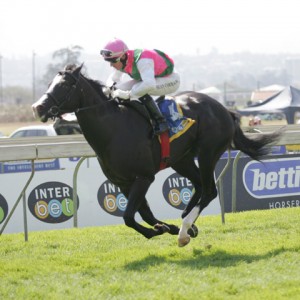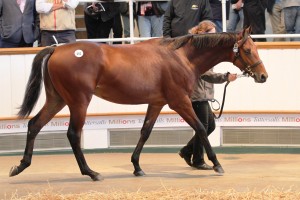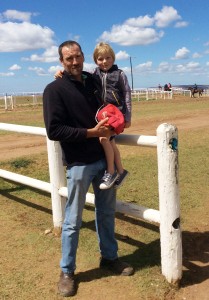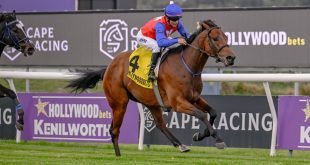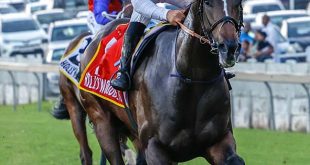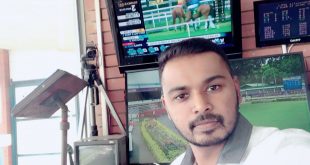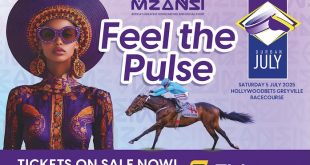Showmetheway targets Merchants
PUBLISHED: October 13, 2014
David Thiselton
The Greyville meeting yesterday started off with a bang when the Mark Dixon-trained Gr 1 Mercury Sprint third-placed Showmetheway got up under Brandon Lerena to beat a small but classy field of sprinters over 1000m.
This six-year-old Muhtafal gelding has benefitted in his last few runs from a change of tactics in that he has been held up before running on and despite needing the run yesterday he once again took off late to get up and beat the well weighted Pej. The Tote favourite was the Gr 1 Golden Horse Casino Sprint winner Normanz, but he didn’t get a good start and proved in need of the run, finishing a 2,05 length fourth at level weights with the winner. Showmetheway should still have plenty of racing in him, as sprinters can blossom in their six-year-old year, and he is being targeted at the Gr 2 Merchants over 1200m at Turffontein at the end of November.
Anton Marcus had a rare blank on Greyville’s Friday night card but he won the second, third and fourth races yesterday, all on favourites, the Dennis Bosch-trained Regardstobroadway, the Greg and Karen Anthony-trained Nottingham Forest and the Glen Kotzen-trained Garden Treasure. It was Bosch’s second Greyville winner of the weekend.
Apprentice Callan Murray made up for his narrow loss on Pej by winning the fifth and sixth races on the Jeff Freedman-trained Royal Denise and the Charles Laird-trained Clipperton Island respectively. Royal Denise was making her polytrack debut and after being backed in from 33/1 to 12/1 she produced a strong finish to get up late. Murray gave Clipperton Island a particularly good front-running ride over 1600m, a fitting way with which to notch up his 20th winner and lose his 4kg claim.
The Michael Roberts-trained Indian Connection won the seventh over 1600m. The Duncan Howells-trained favourite Saratoga Dancer could only manage third after being caught wide and committed early, and this might have cost him his chances of making the R3,85 million Emperor’s Ready To Run Cup field.
Kumaran Naidoo had his second Greyville winner of the weekend when Shivrani, who looked a picture in the parade ring, comfortably won the last over 1900m under Warren Kennedy.
Picture: Showmetheway (right) edges out Pej to win the first at Greyville yesterday (Nkosi Hlophe)
‘Plan B’ for Generalissimo
PUBLISHED: October 13, 2014
David Thiselton
Dennis Drier will be reverting to “Plan B” for Generalissimo after the classy three-year-old colt drew wide in his intended Cape Summer Of Champions Season debut race, the Gr 3 Cape Classic over 1400m on the tight Kenilworth Old Course.
Drier said that the colt would instead run in a forthcoming Graduation Plate over 1200m and added that it still had to be decided whether he would then go the classic route, consisting of the Gr 2 Selangor Cup over 1600m on November 22 and the Gr 1 Grand Parade Cape Guineas on December 20.
Drier said that there had been a couple of cases of travel sickness among his Cape Town string that had arrived at the Phillippi training centre recently, but Generalissimo had not been one of the horses affected.
Picture: Generalissimo (Nkosi Hlophe)
Australia retired to stud
PUBLISHED: October 13, 2014
Australia, the brilliant winner of three Group 1 races, has been retired after a hoof injury cut short his career on the track.
The English and Irish Derby winner was being prepared for next week’s Qipco British Champions Day at Ascot but it was revealed on Saturday morning that he will not race again and instead will head to Coolmore Stud to start his stallion career.
Kevin Buckley, Coolmore’s UK representative, said: “Unfortunately Australia developed a problem in his right-hind hoof during the week and following consultation between the resident farrier in Ballydoyle, our vet and the respective owners a decision was made to retire him to Coolmore.”
Speaking on the Morning Line, Buckley added: “We were all looking forward to Ascot but, as you can appreciate, any type of setback like that jeopardises the training regime and hence we had to make the decision he would not be ready for Champions Day.”
Explaining the injury that means Australia will be unable to retire on a winning note after suffering a shock defeat in the Irish Champion Stakes on his latest and final run, Ballydoyle farrier Jeff Henderson said: “At the beginning of the week we discovered a bit of soreness in the heel, which makes us suspicious of a hoof abscess.
“So we poulticed away at it and the infection came out and there were no soundness issues at all. Then a couple of days later he pulled out lame and on inspection we realised the infection had blown out through the bottom of the foot as well as the top.
“What happens in most cases it undermines and eats away at the attachment of the hoof wall to the sensory structures and therefore rendering it weak and unstable. At that time he was stopped.
“In a case like this it’s going to take a couple of weeks for the stability to come back and in that time we’re losing fitness and therefore he’s not going to be able to join in on Champions Weekend.”
The winner of five races and three at the highest level, Australia retires having earned £2,090,503 in prize-money and looks set for an illustrious career alongside Galileo at Coolmore.
Picture: Sportinglife.com
Records smashed at Tattersalls
PUBLISHED: October 13, 2014
Liesl King
Tattersalls October Book One, Europe’s premier yearling sale ended amidst shattered records on Thursday. The aggregate, just shy of 80 million guineas (R1.5 billion) was the highest ever achieved at a European sale, while John Magnier’s bid of 2.6 million guineas (R48.7 million) for Lot 442 was the highest price paid worldwide for a yearling this year. The median and average also reached new highs of 150,000gns and 235,935gns respectively.
“Book 1 of last year’s Tattersalls October Yearling Sale scaled some enormous heights which makes the record returns at this year’s renewal even more remarkable. A significantly smaller catalogue has produced unprecedented turnover of nearly 80 million guineas. As well as the highest price in the world for an auction yearling for the third consecutive year,” concluded Tattersalls Chairman Edmund Mahony.
After the Coolmore – Darley bidding wars of the nineties, the two super powers are rarely seen bidding against each other these day yet maintained their stranglehold on the racing industry. Tattersalls October 2013 however, saw the new boys on the block, Qatar’s ruling al Thani family, throw down the gauntlet with two staggering yearling purchases of 3.6 million guineas and 5 million guineas respectively. It seemed as if a shift in the power struggle was imminent but order was restored this week with Coolmore’s John Magnier and John Ferguson for Darley snapping up the majority of the top lots. Ferguson topped the buyer’s list with 38 purchases totalling 17,465,000gns, while Magnier, second on the list, bought nine yearlings for 6,885,000gns.
Spectators were treated to a now rare bidding war between Magnier and Ferguson over Lot 214, a Shamardal (USA) colt out of the King’s Stand Stakes winner Cassandra Go (IRE). The colt was eventually knocked down to Ferguson for 1.7 million guineas, a new record price for a yearling in 2014. Late on the last day of the sale however, Lot 442, a Galileo (IRE) half brother to European Champion and sire Harbinger, was knocked down to Magnier for 2.6 million guineas. This despite a low start at 5000gns and a lengthy stall at 60,000gns.
Jehan Malherbe’s Form Bloodstock managed to buy two lots after being under bidder to Ferguson on more than one occasion. Form Bloodstock signed for Lot 27 (120,000gns), an Elusive Quality (USA) filly on behalf of Mary Slack, while Lot 378, a striking Sea The Stars colt was bought for 350,000gns on behalf of Mayfair Speculators. Racing manager, Derek Brugman, confirmed that the colt will remain in the UK to be trained by Mike de Kock.
Picture: Liesl King
Growing respect for Redgrave
PUBLISHED: October 13, 2014
David Thiselton
Glyn Redgrave is gaining increasing prominence among the KZN horseracing fraternity as a valued “horse whisperer”, although he refers to himself as a “horse herder.”
Redgrave rode horses from a tender age and played polo cross for South Africa at U21 level. He had a natural affinity with horses virtually from day one, but his current expertise in equine behaviour also owes a lot to the fact that many of the horses he inherited during his youth were bad tempered sorts. Consequently Redgrave can spot a horse that has issues from the proverbial mile away.
He has also gleaned a lot from the methods of famous “horse whisperers” of the like of Monty Roberts, Pat Parelli and Buck Brannaman. Redgrave revealed that the three cornerstones of human to horse relationships are “trust, love and respect.”
He continued, “You can look at a herd from a distance and immediately see a horse that is saying ‘I don’t like you’. It will always be turning away from you. It is also easy to tell a horse that has been abused. They will try and walk around you and will never approach from the front. The front is the dangerous side of a human being.” Redgrave explained that, besides the physical, horses also mature at a “mental and emotional” level. Therefore, the more unyielding “pressure” a horse has been subjected to at a young age, the harder it will be to reverse the behaviour patterns later on.
In all equine disciplines a horse has to be put under pressure by a trainer at some stage in order to advance. However, the secret is “pressure and release”. If a horse knows there will be a release of pressure, it will become more and more willing and the need to put it under pressure to achieve a goal will become less and less. A simple example of pressure and release is when leading a horse by a halter. If the horse refuses to follow it is pointless pulling it, because it will then fight back. The best approach is simply to maintain the pressure until the horse realises it is not going to win, so steps forward. As soon as the horse steps forward, the pressure on the halter must be released, and hence the horse is rewarded.
“Good schooling is often simply about patience and good timing,” said Redgrave. In the racing game, the pressure and release system can be seen just about everyday on our TV screens. Talented riders are quickly able to relax a horse that begins throwing its head around by subtly releasing pressure on the rein. However, an inexperienced or poor rider will only exacerbate the horse’s headstrong antics by panicking and grabbing a tighter hold of the rein.
During schooling, respect is the first principle that must be taught. After a horse has shown it will be submissive i.e. during lunging it begins licking its lips (equine language interpreted as “I am a herbivore and will not harm you”), it can then be allowed to come in closer. Trust building excercises are the next step. Finally, love must be shown by giving the horse something it will enjoy, such as a watering down after exercise to cool it off.
Another adage Redgraves uses is, “Train the brain and the body will follow.” Poor schooling of a horse will quickly snowball out of control. An example in horseracing is that when a horse has to be loaded on a float to go to the races and refuses to do so, the transporters usually have no option but to use forceful methods, as they have deadlines to meet. The horse will therefore take another step backwards in its relationship with humans due to the inadequate schooling it had received in the first place from its trainer/s.
Of course it would be simplistic to merely blame the current trainer, because they are often quite well down the line in terms of human masters, are often under pressure to race horses as soon as possible and usually have many horses to deal with. “Horse whisperers” can help speed up the process of getting the horse ready for the races and can also help reverse an increasingly bad attitude.
Redgrave pointed out another common phenomenon among sports horses. It has become traditional to do almost everything with a horse from the left side, e.g approach, equip, hold, saddle, mount etc, and a string of horses will invariably ring left-handed too. Therefore, a horse becomes comfortable with pressure from the left side, but will suddenly become alarmed when receiving it from the right. Redgrave said it would not be uncommon for a horse on a bridal path to trot past a foreign object to its left side without batting an eyelid. However, upon returning the object will now be on the right hand side and the horse will suddenly “spook”.
Although the left side traditions will likely never change, Redgrave said it was vital to put pressure on a horse on both left and right hand sides from as early as possible and throughout the schooling process. The starting pens are the most traumatic part of a racehorse’s schooling and this often has to do with a lack of schooling from the right hand side, because the framework of the stalls will obviously be in close proximity to the horse on both sides. A bad experience at the starting stalls can influence a horse’s perception of them for a long time and possibly even forever. Redgrave does wish that the old adage of “prevention is better than cure” could be applied more often to schooling at the pens. A horse that is showing resistance should never be forced to do what it doesn’t want to, but rather the trainer should be notified and further schooling could then be done even it if requires the help of a “horse whisperer”. In the long run this could well save a racehorse’s career.
Redgrave has already earned the respect of many of KZN’s most experienced trainers and will definitely be a name that is going to be heard of regularly in the horseracing industry in time to come.


